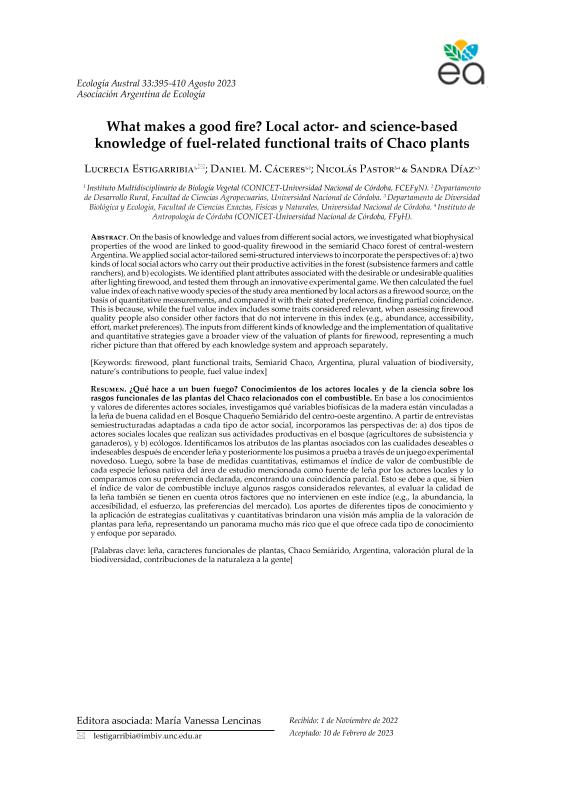Artículo
En base a los conocimientos y valores de diferentes actores sociales, investigamos qué variables biofísicas de la madera están vinculadas a la leña de buena calidad en el Bosque Chaqueño Semiárido del centro-oeste argentino. A partir de entrevistas semiestructuradas adaptadas a cada tipo de actor social, incorporamos las perspectivas de: a) dos tipos de actores sociales locales que realizan sus actividades productivas en el bosque (agricultores de subsistencia y ganaderos), y b) ecólogos. Identificamos los atributos de las plantas asociados con las cualidades deseables o indeseables después de encender leña y posteriormente los pusimos a prueba a través de un juego experimental novedoso. Luego, sobre la base de medidas cuantitativas, estimamos el índice de valor de combustible de cada especie leñosa nativa del área de estudio mencionada como fuente de leña por los actores locales y lo comparamos con su preferencia declarada, encontrando una coincidencia parcial. Esto se debe a que, si bien el índice de valor de combustible incluye algunos rasgos considerados relevantes, al evaluar la calidad de la leña también se tienen en cuenta otros factores que no intervienen en este índice (e.g., la abundancia, la accesibilidad, el esfuerzo, las preferencias del mercado). Los aportes de diferentes tipos de conocimiento y la aplicación de estrategias cualitativas y cuantitativas brindaron una visión más amplia de la valoración de plantas para leña, representando un panorama mucho más rico que el que ofrece cada tipo de conocimiento y enfoque por separado. On the basis of knowledge and values from different social actors, we investigated what biophysical properties of the wood are linked to good-quality firewood in the semiarid Chaco forest of central-western Argentina. We applied social actor-tailored semi-structured interviews to incorporate the perspectives of: a) two kinds of local social actors who carry out their productive activities in the forest (subsistence farmers and cattle ranchers), and b) ecologists. We identified plant attributes associated with the desirable or undesirable qualities after lighting firewood, and tested them through an innovative experimental game. We then calculated the fuel value index of each native woody species of the study area mentioned by local actors as a firewood source, on the basis of quantitative measurements, and compared it with their stated preference, finding partial coincidence. This is because, while the fuel value index includes some traits considered relevant, when assessing firewood quality people also consider other factors that do not intervene in this index (e.g., abundance, accessibility, effort, market preferences). The inputs from different kinds of knowledge and the implementation of qualitative and quantitative strategies gave a broader view of the valuation of plants for firewood, representing a much richer picture than that offered by each knowledge system and approach separately.
¿Qué hace a un buen fuego?: Conocimientos de los actores locales y de la ciencia sobre los rasgos funcionales de las plantas del Chaco relacionados con el combustible
Título:
What makes a good fire?: Local actor- and science-based knowledge of fuel-related functional traits of Chaco plants
Estigarribia, Lucrecia María Fernanda ; Caceres, Daniel Mario
; Caceres, Daniel Mario ; Pastor, Nicolás
; Pastor, Nicolás ; Díaz, Sandra Myrna
; Díaz, Sandra Myrna
 ; Caceres, Daniel Mario
; Caceres, Daniel Mario ; Pastor, Nicolás
; Pastor, Nicolás ; Díaz, Sandra Myrna
; Díaz, Sandra Myrna
Fecha de publicación:
08/2023
Editorial:
Asociación Argentina de Ecología
Revista:
Ecología Austral
ISSN:
0327-5477
Idioma:
Inglés
Tipo de recurso:
Artículo publicado
Clasificación temática:
Resumen
Archivos asociados
Licencia
Identificadores
Colecciones
Articulos(IDACOR)
Articulos de INSTITUTO DE ANTROPOLOGIA DE CORDOBA
Articulos de INSTITUTO DE ANTROPOLOGIA DE CORDOBA
Articulos(IMBIV)
Articulos de INST.MULTIDISCIPL.DE BIOLOGIA VEGETAL (P)
Articulos de INST.MULTIDISCIPL.DE BIOLOGIA VEGETAL (P)
Citación
Estigarribia, Lucrecia María Fernanda; Caceres, Daniel Mario; Pastor, Nicolás; Díaz, Sandra Myrna; ¿Qué hace a un buen fuego?: Conocimientos de los actores locales y de la ciencia sobre los rasgos funcionales de las plantas del Chaco relacionados con el combustible; Asociación Argentina de Ecología; Ecología Austral; 33; 2; 8-2023; 395-410
Compartir
Altmétricas



